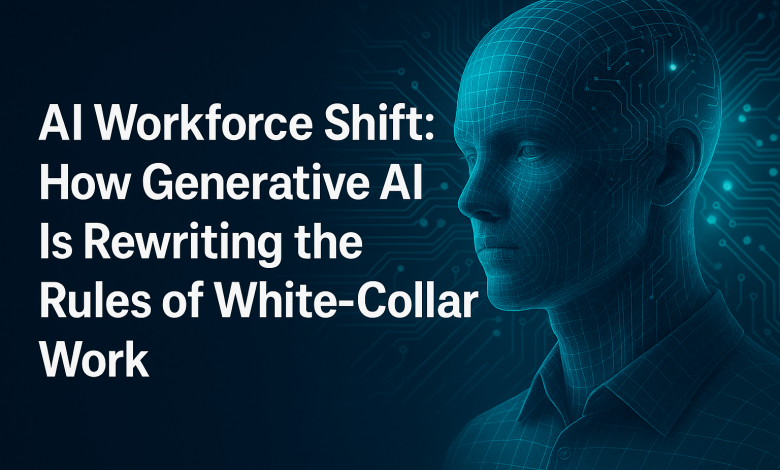
The AI boom isn’t just changing how we search, create, or code — it’s fundamentally rewiring what it means to work.
For decades, automation hit the blue-collar world first: factory robots, self-checkout lanes, warehouse bots. But now, the rise of generative AI — from ChatGPT and Claude to Gemini and Copilot — has turned its gaze on the knowledge economy itself.
For the first time, the people whose value was tied to thinking — not lifting — are seeing their skills replicated by silicon.
From Automation to Cognitive Substitution
Industrial automation replaced routine physical labor. Generative AI replaces routine mental labor.
We’re entering a phase where machines don’t just assist — they generate. Reports, emails, code, presentations, artwork — all can now be spun up in seconds.
This “cognitive substitution” is the true revolution. When OpenAI released ChatGPT in late 2022, most assumed it would be a novelty. Instead, it became a blueprint for how fast intellectual tasks could be commoditized. White-collar productivity is being redefined by prompt fluency rather than Excel shortcuts or corporate hierarchies.
The Rise of the Hybrid Employee
The modern worker is no longer competing with AI — they’re integrating it.
Analysts, designers, marketers, and even lawyers now find themselves using AI tools as cognitive extensions. An HR rep can draft policies in seconds. A copywriter can produce a dozen tone variants before lunch. A software engineer can debug code with GitHub Copilot whispering in their ear.
This isn’t replacement — it’s augmentation. But it also raises uncomfortable questions:
If an AI can perform 80% of a role’s output, does that justify keeping a full-time salary? Or will companies start paying only for the remaining 20% of “human oversight”?
The short answer: both. The workforce is splitting into two camps — AI-empowered workers and AI-replaceable workers — depending on who adapts fastest.
Corporate Adaptation and the Quiet Reorganization
Inside corporations, the AI shift is subtler but seismic. Teams are shrinking, workflows are compressing, and traditional career ladders are warping.
Marketing departments, for example, no longer need a team of 10 content creators when one strategist with access to MidJourney and ChatGPT can produce the same output at scale.
Consulting giants are already retooling. Deloitte and PwC have announced massive investments in AI copilots for internal use. Meanwhile, smaller firms are experimenting with “AI teams” — units built around prompt engineers, automation experts, and AI project managers — roles that barely existed two years ago.
AI isn’t just a new tool. It’s a new organizing principle for companies.
Job Creation vs. Job Compression
Every technological revolution destroys and creates roles — but AI’s speed makes the shift more volatile.
According to Goldman Sachs, up to 300 million jobs could be impacted by AI automation, but that same disruption could generate new categories: AI auditors, model ethicists, data compliance officers, and prompt engineers.
The challenge? The new roles require interdisciplinary fluency — mixing technical knowledge, ethics, business strategy, and creativity. The average worker trained for a single function may find themselves outdated in a few short years.
It’s not that AI will wipe out employment — it will wipe out redundancy. Anyone who can’t leverage AI effectively will find themselves lagging behind those who can.
The Skill Gap Problem
The emerging skill gap isn’t about coding — it’s about communicating with AI systems.
Prompt engineering, contextual framing, and data literacy are becoming the new workplace superpowers.
An employee who can translate business intent into AI-readable logic instantly becomes more valuable. In contrast, workers who cling to rigid job definitions risk being marginalized by software that never sleeps.
Forward-thinking companies are already running AI literacy programs. Accenture, for instance, trained hundreds of thousands of employees on generative AI usage across departments. Microsoft has embedded Copilot into nearly every Office product — meaning “AI fluency” will soon be a baseline expectation, not a competitive edge.
The Psychological Shift: From Expert to Curator
Perhaps the most under-discussed effect is psychological.
Many professionals built their identity on expertise — being the person who “knows.” But AI now challenges that status. When a machine can summarize, draft, or analyze faster than you, what becomes of your authority?
The answer lies in curation. The human role shifts from “creating from scratch” to “selecting what matters.”
Writers, designers, and analysts are morphing into editors of machine-generated output. The ability to filter noise, judge accuracy, and add human context becomes more critical than ever. Expertise is no longer about what you know — it’s about what you validate.
Ethics and Economic Inequality
As AI productivity surges, so does inequality. High-skill, high-income workers who can integrate AI effectively will multiply their output and compensation. Meanwhile, low- and mid-level white-collar workers may face stagnant wages or redundancy.
This is the “AI wage gap” — a new form of digital stratification.
Some economists predict a future where AI-enhanced individuals manage fleets of virtual assistants, while millions of traditional jobs evaporate. Without structural reform — universal basic income, reskilling programs, or new tax models — the gains of AI will likely concentrate in the hands of those already positioned to benefit.
The Future of the Office
Even the office itself is evolving. Remote work normalized digital collaboration; AI is now normalizing asynchronous cognition.
Team members may soon interact not just with colleagues but with autonomous agents trained on their company’s data.
Meetings could include AI note-takers, decision-summarizers, and project copilots capable of analyzing next steps before humans even log off.
The next version of “teamwork” won’t be person-to-person — it’ll be human-to-machine-to-human.
Adapt or Be Automated
The generative AI revolution is less about technology and more about adaptability.
Employees who embrace AI as a multiplier — not a menace — will dominate the new economy. Those who reject it may find themselves phased out faster than they realize.
In the coming years, career security won’t come from stability — it’ll come from velocity,
Learn fast, iterate faster, and let AI handle the rest.

